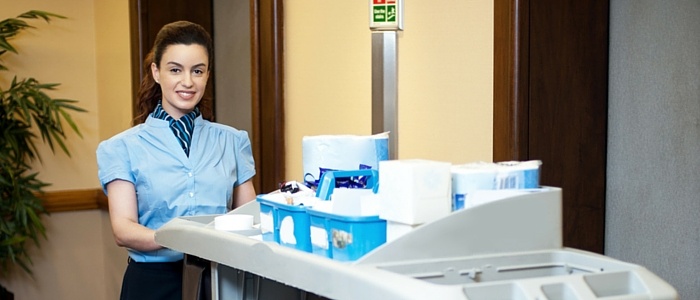 The hospitality industry is a prime candidate to implement ergonomic solutions. Workers in restaurants and lodging facilities perform many types of jobs. Many of these jobs are very physical. Dishwashers, servers, bartenders and luggage handlers are all at risk of on-the-job injuries.
The hospitality industry is a prime candidate to implement ergonomic solutions. Workers in restaurants and lodging facilities perform many types of jobs. Many of these jobs are very physical. Dishwashers, servers, bartenders and luggage handlers are all at risk of on-the-job injuries.
Cintas Corporation released a list of the top four restaurant injuries in 2011. Among them were sprains and strains as they stated, "Misplaced or hard-to-reach items can cause worker injury due to overreaching or trips. Restaurant workers can also suffer from strains due to improper lifting." Tweet this quote.
But the Riskiest Job Is Housekeeping.
Housekeepers lift and carry heavy objects. They push heavy carts and vacuums. They reach high and low to clean rooms. They do it over and over again, every day.
The Centers for Disease Control says about 1.8 million people worked in the Traveler/Accommodation industry in 2008. Of those, 400,000 were hotel housekeepers. Among other things, they are at risk for:
Chris Montrossis vice-president of CKI Risk Solutions. His company provides ergonomic solutions for the hotel industry. He says housekeepers clean 15-20 rooms a day. Compared to the average service industry worker, they are:
In the hospitality industry, about 62% of housekeeping injuries are musculoskeletal. Bed making is the leading cause. Mattresses are bigger and far heavier than they used to be. That increases lifting strain. Mattresses sit at below-the-waist level. They are often in close quarters with walls or other furniture. Housekeepers must assume awkward positions to make the bed.
Montross quotes a study from the University of California at San Francisco:
He notes that the hospitality industry pays $500 million a year in workers’ comp claims, just from repetitive motion injuries. Housekeepers account for about 70% of those claims.
These Are All GoodReasons to Adopt Ergonomic Solutions
Essential considerations for choosing ergonomic solutions in any industry are:
The Ohio State University conducted an extensive study of housekeeping ergonomics. The study was funded by OSHA. Researchers noted that among cumulative trauma injuries for housekeepers:
Ohio State condensed their findings into a handy two-page brochure. It includes key recommendations for ergonomic solutions that address:
Recommended solutions address system-wide modifications. They also include alternative work methods that teach housekeepers safer body mechanics. And they use alternative ergonomic tools and equipment. These things make it easier to use proper body postures and movements. Researchers also outlined ways to improve housekeeper health such as:
Canada’s British Columbia province has a WorkSafe program for employers. They have created several handy “ergonomic tips” guides for specific hospitality positions.
Ergonomic solutions can help hospitality companies reduce direct and indirect costs of injuries. But these solutions do more than that. Montross concludes that, “Companies committed to continuous safety and health improvements … consistently outperform their competitors in operational efficiency, customer service and profitability.”
Locate one of our nationwide OnSite Physio therapists now.
PO BOX 160070
Altamonte Springs, Fl 32716
referrals@physnet.com
Phone: 866-907-4797
CONTACT US|
©2021 PhysNet, LLC. All Rights Reserved.
|
 |